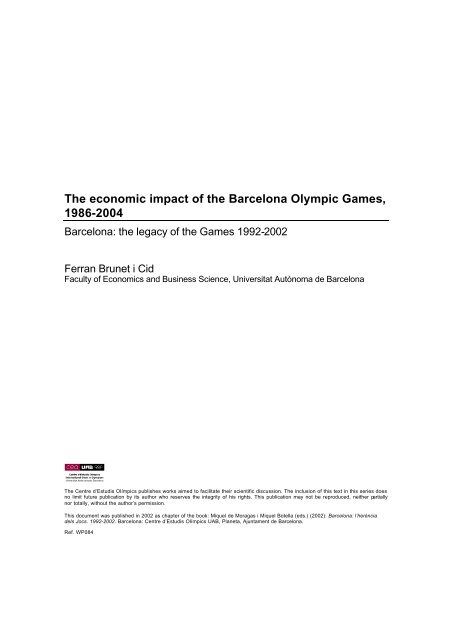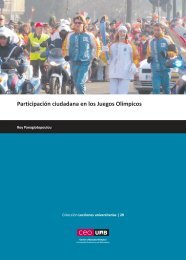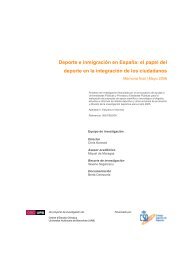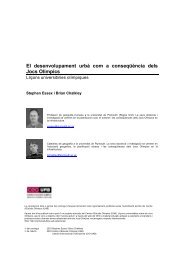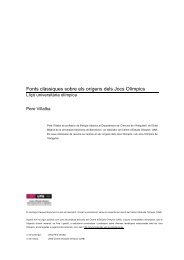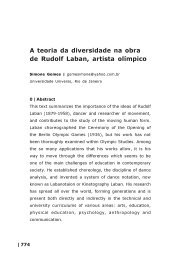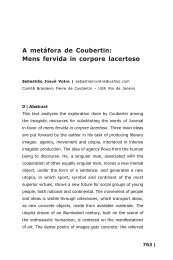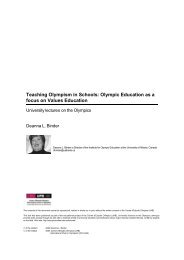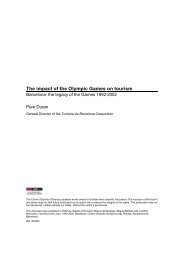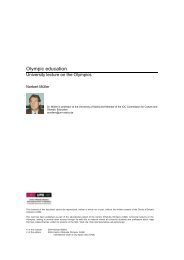The economic impact of the Barcelona Olympic Games, 1986-2004
The economic impact of the Barcelona Olympic Games, 1986-2004
The economic impact of the Barcelona Olympic Games, 1986-2004
Create successful ePaper yourself
Turn your PDF publications into a flip-book with our unique Google optimized e-Paper software.
<strong>The</strong> <strong>economic</strong> <strong>impact</strong> <strong>of</strong> <strong>the</strong> <strong>Barcelona</strong> <strong>Olympic</strong> <strong>Games</strong>,<br />
<strong>1986</strong>-<strong>2004</strong><br />
<strong>Barcelona</strong>: <strong>the</strong> legacy <strong>of</strong> <strong>the</strong> <strong>Games</strong> 1992-2002<br />
Ferran Brunet i Cid<br />
Faculty <strong>of</strong> Economics and Business Science, Universitat Autònoma de <strong>Barcelona</strong><br />
<strong>The</strong> Centre d’Estudis Olímpics publishes works aimed to facilitate <strong>the</strong>ir scientific discussion. <strong>The</strong> inclusion <strong>of</strong> this text in this series does<br />
no limit future publication by its author who reserves <strong>the</strong> integrity <strong>of</strong> his rights. This publication may not be reproduced, nei<strong>the</strong>r partially<br />
nor totally, without <strong>the</strong> author’s permission.<br />
This document was published in 2002 as chapter <strong>of</strong> <strong>the</strong> book: Miquel de Moragas i Miquel Botella (eds.) (2002): <strong>Barcelona</strong>: l’herència<br />
dels Jocs. 1992-2002. <strong>Barcelona</strong>: Centre d’Estudis Olímpics UAB, Planeta, Ajuntament de <strong>Barcelona</strong>.<br />
Ref. WP084
To refer to this document, you can use <strong>the</strong> following reference:<br />
© 2005 Centre d’Estudis Olímpics UAB<br />
Ferran Brunet - Economic <strong>impact</strong> <strong>of</strong> <strong>the</strong> <strong>Barcelona</strong> <strong>Olympic</strong> <strong>Games</strong><br />
Brunet, Ferran (2005): <strong>The</strong> <strong>economic</strong> <strong>impact</strong> <strong>of</strong> <strong>the</strong> <strong>Barcelona</strong> <strong>Olympic</strong> <strong>Games</strong>, <strong>1986</strong>-<strong>2004</strong>: <strong>Barcelona</strong>: <strong>the</strong> legacy <strong>of</strong> <strong>the</strong><br />
<strong>Games</strong>, 1992-2002 [online article]. <strong>Barcelona</strong>: Centre d’Estudis Olímpics UAB. [Date <strong>of</strong> consulted: dd/mm/yy] Available<br />
from: http://olympicstudies.uab.es/pdf/wp084_eng.pdf<br />
[Date <strong>of</strong> publication: 2005]<br />
2
Index <strong>of</strong> contents<br />
© 2005 Centre d’Estudis Olímpics UAB<br />
Ferran Brunet - Economic <strong>impact</strong> <strong>of</strong> <strong>the</strong> <strong>Barcelona</strong> <strong>Olympic</strong> <strong>Games</strong><br />
Introduction.............................................................................................................................................. 5<br />
I. <strong>1986</strong>-1992: Resources ....................................................................................................................... 5<br />
<strong>The</strong> <strong>Barcelona</strong>’92 organisational model.......................................................................................... 5<br />
Economic resources <strong>of</strong> <strong>Barcelona</strong>’92.............................................................................................. 6<br />
<strong>Olympic</strong> Organising Committee income, 1964-2008 .................................................................... 6<br />
Construction work for <strong>the</strong> <strong>Barcelona</strong> <strong>Games</strong> ................................................................................. 6<br />
<strong>The</strong> financial balance <strong>Barcelona</strong> 1992............................................................................................ 7<br />
II. 1992-<strong>2004</strong>: Impact............................................................................................................................. 8<br />
<strong>The</strong> <strong>economic</strong> <strong>impact</strong> <strong>of</strong> <strong>the</strong> <strong>Games</strong>................................................................................................ 8<br />
<strong>The</strong> response capacity <strong>of</strong> <strong>Olympic</strong> host cities: <strong>Barcelona</strong> as an exception.............................. 9<br />
<strong>The</strong> “<strong>Barcelona</strong> <strong>Olympic</strong> Impact Model”.......................................................................................... 9<br />
Comparison <strong>of</strong> <strong>Olympic</strong> <strong>impact</strong>s, 1964-2008: <strong>Barcelona</strong> as an exception................................ 10<br />
III. <strong>2004</strong>-2010: Strategy and perspectives.......................................................................................... 10<br />
Investment in infrastructure and urban transformation, <strong>1986</strong>-2010............................................ 10<br />
<strong>The</strong> <strong>Olympic</strong> legacy and <strong>Barcelona</strong>’s strategic perspectives ...................................................... 11<br />
<strong>Barcelona</strong>, model and reality............................................................................................................ 12<br />
Conclusions ............................................................................................................................................. 12<br />
Tables ....................................................................................................................................................... 14<br />
Figures...................................................................................................................................................... 18<br />
Bibliography............................................................................................................................................. 26<br />
3
© 2005 Centre d’Estudis Olímpics UAB<br />
Ferran Brunet - Economic <strong>impact</strong> <strong>of</strong> <strong>the</strong> <strong>Barcelona</strong> <strong>Olympic</strong> <strong>Games</strong><br />
4
Introduction<br />
© 2005 Centre d’Estudis Olímpics UAB<br />
Ferran Brunet - Economic <strong>impact</strong> <strong>of</strong> <strong>the</strong> <strong>Barcelona</strong> <strong>Olympic</strong> <strong>Games</strong><br />
<strong>Barcelona</strong>’s dream <strong>of</strong> hosting an <strong>Olympic</strong> <strong>Games</strong> which would achieve <strong>the</strong> highest levels <strong>of</strong> human and<br />
sporting quality was fulfilled. In <strong>the</strong> process, <strong>the</strong> city itself underwent an impressive urban transformation.<br />
Overall, we can say:<br />
A. <strong>The</strong> <strong>Barcelona</strong> <strong>Games</strong> were a total success in organisational and sporting terms.<br />
B. <strong>The</strong> urban transformation generated by <strong>the</strong> <strong>Games</strong> had far-reaching <strong>economic</strong> and social<br />
<strong>impact</strong>s .<br />
C. <strong>Barcelona</strong> has been highly successfully in harnessing <strong>the</strong> impetus and legacy <strong>of</strong> <strong>the</strong> <strong>Games</strong> : by<br />
2001, <strong>the</strong> city was ranked as <strong>the</strong> Europe’s sixth most attractive.<br />
Consequently, <strong>the</strong> <strong>Barcelona</strong> <strong>Games</strong>, <strong>the</strong>ir organisation and <strong>impact</strong>, have become a model from <strong>the</strong><br />
sporting, organisational, <strong>economic</strong>, social and urban planning perspectives . In this article sets out to study<br />
<strong>the</strong> following:<br />
I. <strong>The</strong> organis ation <strong>of</strong> <strong>the</strong> 2002 <strong>Games</strong> in terms <strong>of</strong> <strong>the</strong> model adopted, methods and resources used<br />
over <strong>the</strong> <strong>1986</strong>-1992 period.<br />
II. <strong>The</strong> <strong>impact</strong> <strong>of</strong> <strong>the</strong> investments made on <strong>economic</strong> activity, employment, income, construction,<br />
tourism and transport, with special emphasis on <strong>the</strong> 1992-2002 period.<br />
III. <strong>The</strong> city’s harnessing <strong>of</strong> <strong>the</strong> <strong>Olympic</strong> impetus to improve its strategic position with a view to <strong>the</strong><br />
future (2002-2010).<br />
I. <strong>1986</strong>-1992: Re sources<br />
Preparing for <strong>the</strong> <strong>Games</strong>: an opportunity to foster investment, organisational excellence and urban<br />
transformation <strong>of</strong> <strong>the</strong> city<br />
In organising <strong>the</strong> <strong>Olympic</strong> <strong>Games</strong>, <strong>Barcelona</strong> aimed to ensure sporting excellence in keeping with <strong>the</strong><br />
<strong>Olympic</strong> spirit, and also to bring about a major urban transformation leading to improved quality <strong>of</strong> life and<br />
greater attractiveness for <strong>the</strong> city as a whole.<br />
<strong>The</strong> <strong>Barcelona</strong>’92 Organisational Model<br />
<strong>The</strong> key to <strong>the</strong> success <strong>of</strong> <strong>the</strong> <strong>Barcelona</strong> <strong>Games</strong> (Samaranch, 1992) lies in <strong>the</strong> strength <strong>of</strong> <strong>the</strong> objectives<br />
(organisational excellence and urban <strong>impact</strong>), <strong>the</strong> inter-institutional consensus , <strong>the</strong> use <strong>of</strong> special<br />
management bodies , mixed private-public funding models , and also <strong>the</strong> successful harnessing <strong>of</strong> <strong>the</strong><br />
<strong>Olympic</strong> impetus and attracting <strong>of</strong> investments.<br />
<strong>The</strong>se features and <strong>the</strong> excellent results achieved (<strong>Barcelona</strong> City Hall, various years) 1 constitute a<br />
“<strong>Barcelona</strong> model” for urban transformation linked to major events. Figure 1 sets out <strong>the</strong> main features <strong>of</strong><br />
this model.<br />
5
© 2005 Centre d’Estudis Olímpics UAB<br />
Ferran Brunet - Economic <strong>impact</strong> <strong>of</strong> <strong>the</strong> <strong>Barcelona</strong> <strong>Olympic</strong> <strong>Games</strong><br />
Economic resources <strong>of</strong> <strong>Barcelona</strong>’92: <strong>the</strong> cost <strong>of</strong> <strong>the</strong> <strong>Games</strong> and source <strong>of</strong> funding<br />
A distinction must be drawn between organisational costs (items not usable after <strong>the</strong> <strong>Games</strong>) and<br />
investment in building work and facilities which would continue to serve <strong>the</strong> city in <strong>the</strong> future. <strong>The</strong><br />
organisational costs are in effect <strong>the</strong> genuine “net cost”, since <strong>the</strong>ir functions end with termination <strong>of</strong> <strong>the</strong><br />
<strong>Games</strong> . <strong>The</strong>refore, <strong>the</strong> aim was to minimise <strong>the</strong>se organisational costs . In contrast, facilities and<br />
infrastructure constitute part <strong>of</strong> <strong>the</strong> <strong>Olympic</strong> Legacy, <strong>the</strong> benefits <strong>of</strong> which continue after <strong>the</strong> <strong>Games</strong>, and<br />
were <strong>the</strong>refore to be maximised.<br />
<strong>The</strong> resources allocated to organisational costs and investments in facilities and infrastructure, and <strong>the</strong>ir<br />
<strong>impact</strong>, are set out in Table 1. <strong>The</strong>re is a major difference between total organisational costs (1,364 million<br />
dollars – hereafter, M $, mainly funded by <strong>the</strong> Organising Committee) and <strong>the</strong> investments in infrastructure<br />
and facilities (8,012 M $). <strong>The</strong> latter accounted for 85.5% <strong>of</strong> total <strong>Olympic</strong> spending (Figure 4).<br />
COOB’92 closed <strong>the</strong>ir accounts in July 1993: spending had totalled 195,594 million pesetas , that is,<br />
1,638 M $ (equivalent to 1,678 M $ at 2000 rates), with a surplus <strong>of</strong> 3 M $ (COOB’92, 1993). 2<br />
Income accruing directly to COOB’92 itself accounted for 75.2% <strong>of</strong> <strong>the</strong> total. <strong>The</strong> main sources <strong>of</strong> this<br />
income were sponsors hip and television rights . In organisational costs, <strong>the</strong> main outgoings were for<br />
television and press facilities (International Communications Centre and technology), <strong>the</strong> competitions<br />
<strong>the</strong>mselves and <strong>Olympic</strong> family services (Table 1 and Figure 2 for exact distribution). <strong>The</strong> main COOB’92<br />
costs lay in services (49.9% <strong>of</strong> <strong>the</strong> total), followed by investments in infrastructure (33.8%).<br />
<strong>Olympic</strong> Organising Committee income, 1964-2008<br />
In comparison with o<strong>the</strong>r <strong>Olympic</strong> <strong>Games</strong>, <strong>the</strong> <strong>Barcelona</strong> <strong>Games</strong> were outstanding for <strong>the</strong> increased<br />
Organising Committee income, investment in facilities and infrastructure, and <strong>impact</strong> (Figures 3, 7 and 9)<br />
(International <strong>Olympic</strong> Committee, 2001, 2002a and 2002b). <strong>The</strong> <strong>Games</strong> continue to have an <strong>impact</strong>.<br />
a) In general terms, as an organisational model – <strong>the</strong> memory <strong>of</strong> <strong>the</strong> excellent organisational and<br />
sporting results lives on (Rogge, 2002); and as a model <strong>of</strong> urban transformation;<br />
b) Locally, in <strong>the</strong> present effects <strong>of</strong> <strong>the</strong> <strong>Olympic</strong> investments, in <strong>the</strong> scale <strong>of</strong> <strong>the</strong> <strong>Olympic</strong> Legacy and<br />
<strong>the</strong> far-reaching <strong>impact</strong>s <strong>of</strong> <strong>the</strong> city’s improved strategic positioning.<br />
c) Herein lies our interest in studying <strong>the</strong> investment in infrastructure and facilities generated by <strong>the</strong><br />
<strong>Barcelona</strong> <strong>Games</strong>, <strong>the</strong> city’s harnessing <strong>of</strong> <strong>the</strong> <strong>Olympic</strong> legacy, and <strong>the</strong> ongoing investment and<br />
urban renewal process (Brunet, 1995a and 1996).<br />
Construction work for <strong>the</strong> <strong>Barcelona</strong> <strong>Games</strong><br />
<strong>The</strong> central Spanish government and <strong>Barcelona</strong> City Hall set up a joint venture, <strong>Barcelona</strong> Holding<br />
Olímpic, S.A. (HOLSA), to facilitate <strong>the</strong> investment process. In an excellent example <strong>of</strong> mixed public-<br />
private funding, HOLSA built <strong>the</strong> main <strong>Olympic</strong> facilities , <strong>the</strong> bulk <strong>of</strong> <strong>the</strong> 78 km <strong>of</strong> new road infrastructure<br />
and <strong>the</strong> <strong>Olympic</strong> Village.<br />
Given <strong>the</strong> <strong>Barcelona</strong>’92 objectives, a vast amount <strong>of</strong> construction work was required, and much more was<br />
also indirectly generated, most <strong>of</strong> <strong>the</strong> latter not being directly necessary for <strong>the</strong> holding <strong>of</strong> <strong>the</strong> <strong>Games</strong>. This<br />
is one <strong>of</strong> <strong>the</strong> aims <strong>of</strong> candidate host cities : to generate construction <strong>of</strong> as much infrastructure and facilities<br />
6
© 2005 Centre d’Estudis Olímpics UAB<br />
Ferran Brunet - Economic <strong>impact</strong> <strong>of</strong> <strong>the</strong> <strong>Barcelona</strong> <strong>Olympic</strong> <strong>Games</strong><br />
as possible which will serve <strong>the</strong> city in <strong>the</strong> aftermath <strong>of</strong> <strong>the</strong> event itself. Total such spending linked to <strong>the</strong><br />
<strong>Games</strong> over <strong>the</strong> <strong>1986</strong>-1993 period amounted to 8,012 M $ (for details see Tables 1 and 3).<br />
<strong>The</strong> main construction work was as follows :<br />
I. Road and transport infrastructure;<br />
II. Housing, <strong>of</strong>fices and business premises ;<br />
III. Telecommunications and services;<br />
IV. Hotels ;<br />
V. Sports facilities ;<br />
VI. Environmental infrastructure.<br />
A total <strong>of</strong> 61.5% <strong>of</strong> <strong>Olympic</strong> funding was allocated for building work. This illustrates a key feature <strong>of</strong><br />
<strong>Barcelona</strong>’92: its structuring effect on <strong>the</strong> city. 3 <strong>The</strong> deepest <strong>impact</strong>s <strong>of</strong> <strong>the</strong> <strong>Olympic</strong> investments are in <strong>the</strong><br />
long-term.<br />
<strong>The</strong> <strong>Barcelona</strong> rondes or ring-roads, <strong>the</strong> re-opening <strong>of</strong> <strong>the</strong> city to its seafront via construction <strong>of</strong> <strong>the</strong><br />
<strong>Olympic</strong> Village, <strong>the</strong> creation <strong>of</strong> a range <strong>of</strong> new urban sub-centres and <strong>the</strong> <strong>Olympic</strong> facilities at Montjuïc,<br />
<strong>the</strong> Diagonal and Vall d’Hebron, were <strong>the</strong> main <strong>Barcelona</strong> building projects (HOLSA, 1990).<br />
<strong>The</strong> scale <strong>of</strong> <strong>the</strong> urban transformation arising from <strong>the</strong> <strong>Games</strong> was immense: new roads represented an<br />
increase <strong>of</strong> 15% over those existing in <strong>1986</strong>; new sewage systems, 17%, and new green areas and<br />
beaches , 78%. Ano<strong>the</strong>r outstanding feature <strong>of</strong> <strong>the</strong> <strong>Games</strong> was regional decentralisation: <strong>Olympic</strong><br />
investment also went to numerous sub-host cities . Of <strong>the</strong> total investment, only 38.5% was located in<br />
<strong>Barcelona</strong> city. <strong>The</strong> immediate <strong>impact</strong> was, <strong>the</strong>refore, felt throughout <strong>the</strong> region.<br />
Ano<strong>the</strong>r important aspect was that construction <strong>of</strong> sports facilities accounted for only 9.1% <strong>of</strong> <strong>the</strong> total<br />
investment. This small percentage reflects <strong>the</strong> great volume <strong>of</strong> additional indirect investment attracted by<br />
<strong>the</strong> impetus <strong>of</strong> <strong>the</strong> <strong>Games</strong> .<br />
A total <strong>of</strong> 36.8% <strong>of</strong> <strong>the</strong> <strong>Olympic</strong> building work was promoted by <strong>the</strong> private sector, and one-third <strong>of</strong> this was<br />
funded with foreign capital. Private investment focused on:<br />
I. Housing<br />
II. Hotels<br />
III. Business Centres<br />
<strong>The</strong> high level <strong>of</strong> private investment was sparked by expectations <strong>of</strong> improvement in <strong>the</strong> city’s<br />
attractiveness (Roldán, 1992).<br />
<strong>The</strong> financial balance <strong>Barcelona</strong> 1992<br />
<strong>The</strong> <strong>Games</strong> require public resources which, in turn, generate fur<strong>the</strong>r public resources . <strong>The</strong> <strong>the</strong>sis is that if<br />
<strong>the</strong> <strong>Games</strong> are fostered by <strong>the</strong> public sector, <strong>the</strong> public administration will itself benefit far in excess <strong>of</strong> <strong>the</strong><br />
cost <strong>of</strong> <strong>the</strong> investment. <strong>The</strong> aim was <strong>the</strong>n to minimise public funding for organisational costs , and to direct<br />
it towards construction <strong>of</strong> infrastructure and facilities .<br />
7
© 2005 Centre d’Estudis Olímpics UAB<br />
Ferran Brunet - Economic <strong>impact</strong> <strong>of</strong> <strong>the</strong> <strong>Barcelona</strong> <strong>Olympic</strong> <strong>Games</strong><br />
Public funding may rise to levels above those originally foreseen or promised. However, <strong>the</strong> greater <strong>the</strong><br />
public investment, <strong>the</strong> greater <strong>the</strong> private investment which will follow, and <strong>the</strong> greater <strong>the</strong> legacy, <strong>the</strong><br />
additional activity and employment generated. Public return will also rise in line with increased investment<br />
and activity.<br />
<strong>The</strong> financial balance sets out all <strong>the</strong> <strong>Olympic</strong>-related public administration costs and <strong>the</strong> income<br />
generated by <strong>the</strong> <strong>Games</strong> , both directly and indirectly.<br />
Table 2 sets out <strong>the</strong> financial balance <strong>of</strong> <strong>the</strong> <strong>Barcelona</strong> <strong>Games</strong> . Two periods are considered: <strong>the</strong><br />
preparatory period (<strong>1986</strong>-1992), and <strong>the</strong> aftermath <strong>of</strong> <strong>the</strong> <strong>Games</strong> . Up to 1992, we see that public<br />
infrastructure costs were high, but so was public administration income due to taxable <strong>Olympic</strong> activities .<br />
After 1992, public <strong>Olympic</strong>-related spending was limited to maintenance <strong>of</strong> <strong>the</strong> Legacy, yet income deriving<br />
from greater private capital and <strong>economic</strong> activity generated by <strong>the</strong> <strong>Games</strong> had risen sharply. <strong>The</strong>refore, in<br />
both periods, <strong>the</strong> financial balance is clearly a positive one.<br />
Even by <strong>2004</strong> <strong>the</strong>n, public investment in <strong>the</strong> <strong>Games</strong> had received ample returns, as shown in Figure 7.<br />
<strong>The</strong> financial balance presented here has been estimated with an error margin or +/- 15%. However, it<br />
does not include income deriving from company social security contributions . Including this figure, <strong>the</strong><br />
surplus would be as follows: + 6,835 M $ for <strong>1986</strong>-1992; + 2,608 M $ for 1993-2001; + 3,873 M $ for 2002-<br />
2010.<br />
II. 1992-<strong>2004</strong>: Impact<br />
Successful harnessing <strong>of</strong> <strong>the</strong> <strong>Olympic</strong> impetus and generation <strong>of</strong> fur<strong>the</strong>r investment and activity<br />
<strong>The</strong> <strong>impact</strong> <strong>of</strong> <strong>the</strong> city’s nomination as <strong>Olympic</strong> host city was immediate: unemployment underwent a<br />
dramatic fall, <strong>the</strong> housing market came back to life and, <strong>of</strong> course, <strong>the</strong> construction industry underwent a<br />
boom (Brunet, 1995b).<br />
However, one decade later, it is surprising to find that this expansive trend continues : 1993 was worse<br />
than 1992 – as it was in <strong>the</strong> entire region, and indeed in all <strong>of</strong> western Europe; however, every year since<br />
has seen new growth records on all indicators: employment, investment, income, attractiveness, etc. Not<br />
only did <strong>Barcelona</strong> react well to <strong>the</strong> <strong>Games</strong>, it succeeded in maintaining <strong>the</strong> growth generated, on a scale<br />
never seen before.<br />
<strong>The</strong> <strong>economic</strong> <strong>impact</strong> <strong>of</strong> <strong>the</strong> <strong>Games</strong><br />
<strong>The</strong> labour market <strong>of</strong> <strong>Barcelona</strong> and its hinterland benefited substantially in <strong>the</strong> run-up period to <strong>the</strong><br />
<strong>Games</strong> . <strong>The</strong> numbers unemployed fell from an all-time high <strong>of</strong> 127,774, in November <strong>1986</strong>, to as low as<br />
60,885, by July 1992, during <strong>the</strong> <strong>Games</strong> <strong>the</strong>mselves (Figure 6). Between October <strong>1986</strong> and August 1992,<br />
<strong>Barcelona</strong>’s general unemployment rate fell from 18.4% to 9.6%, while <strong>the</strong> Spanish figures were 20.9%<br />
and 15.5%, respectively. In <strong>the</strong> preparatory phase, <strong>Olympic</strong>-based activity generated annual occupation<br />
rates <strong>of</strong> an additional 35,309 persons , on average.<br />
8
© 2005 Centre d’Estudis Olímpics UAB<br />
Ferran Brunet - Economic <strong>impact</strong> <strong>of</strong> <strong>the</strong> <strong>Barcelona</strong> <strong>Olympic</strong> <strong>Games</strong><br />
In addition, <strong>Olympic</strong>-linked investment in infrastructure and facilities led to additional permanent<br />
employment for an estimated 20,019 people. <strong>The</strong>refore, <strong>the</strong> average annual effect over <strong>the</strong> 1987-1993<br />
period <strong>of</strong> <strong>Barcelona</strong>’92 was employment for some 59,328 persons. From this we can conclude that at least<br />
88.7% <strong>of</strong> <strong>the</strong> reduction in unemployment registered in <strong>Barcelona</strong> between November <strong>1986</strong> and July 1992<br />
(66,889 fewer unemployed) was due to <strong>the</strong> <strong>Games</strong> .<br />
After <strong>the</strong> <strong>Games</strong>, unemployment in <strong>Barcelona</strong> rose by 21,000 persons, a figure approximately equivalent<br />
to <strong>the</strong> annual employment provided by COOB’92. Over <strong>the</strong> following years, unemployment fell significantly<br />
(Figure 6). <strong>The</strong> investment generated by <strong>the</strong> <strong>Games</strong> provided a s<strong>of</strong>t mattress, breaking <strong>the</strong> fall in a context<br />
<strong>of</strong> general depression. <strong>Barcelona</strong>’s economy proved resistant to <strong>the</strong> widespread repression and, after<br />
1994, once again began to create employment. Until 1993, 41,450 new jobs had been created,<br />
representing a halving <strong>of</strong> <strong>the</strong> unemployment figures . In 1993 and 1994, <strong>the</strong> numbers in unemployment<br />
increased by 18,000 persons ; however, after 1995 unemployment was to fall, thanks, in part, to some<br />
20,230 permanent jobs deriving from <strong>Olympic</strong> investment (a legacy <strong>of</strong> 956,000 million pesetas in company<br />
capital).<br />
<strong>The</strong> remaining <strong>economic</strong> indicators confirm <strong>Barcelona</strong>’s progress over <strong>the</strong> years after <strong>the</strong> <strong>Games</strong> . Let us<br />
take <strong>the</strong> construction sector, for example. Graph B in Figure 6 sets out <strong>the</strong> increased consumption <strong>of</strong><br />
cement – multiplied by 2.5 – between <strong>1986</strong> and 1992, and this figure was to grow to a total <strong>of</strong> 3.5 times <strong>the</strong><br />
<strong>1986</strong> figure by 2001. House building also expanded, despite <strong>the</strong> fact that as a city <strong>Barcelona</strong>’s building<br />
potential had already been relatively well exploited.<br />
<strong>The</strong> response capacity <strong>of</strong> <strong>Olympic</strong> host cities: <strong>Barcelona</strong> as an exception<br />
Between <strong>1986</strong> and 2000, <strong>Barcelona</strong>’s hotel capacity increased threefold. Parallel to this, <strong>the</strong> number <strong>of</strong><br />
visitors from abroad visiting <strong>the</strong> city doubled, reaching a total <strong>of</strong> 3.5 million visitors per year. In comparison<br />
with <strong>the</strong> o<strong>the</strong>r host cities over <strong>the</strong> last 12 years, Seoul, Atlanta and Sydney, <strong>Barcelona</strong>’s results are<br />
outstanding. In some areas, <strong>the</strong>y are truly exceptional, as for example, in <strong>the</strong> figures on hotel capacity and<br />
<strong>the</strong> number <strong>of</strong> foreign visitors .<br />
<strong>Barcelona</strong>’s response to <strong>the</strong> <strong>Olympic</strong> stimulus has been more intense and sustained than that <strong>of</strong> <strong>the</strong> o<strong>the</strong>r<br />
host cities. This has made <strong>Barcelona</strong>’92 a model in so far as <strong>impact</strong> is concerned. This is where<br />
<strong>Barcelona</strong>’s performance was exceptional: in its extraordinary and sustained capacity to ride <strong>the</strong> <strong>Olympic</strong><br />
wave.<br />
<strong>The</strong> “<strong>Barcelona</strong> <strong>Olympic</strong> Impact Model”<br />
<strong>The</strong> immediate <strong>impact</strong> <strong>of</strong> <strong>the</strong> <strong>Olympic</strong> <strong>Games</strong> was highly notable. However, what was truly surprising was<br />
<strong>the</strong> <strong>impact</strong> and scale <strong>of</strong> <strong>the</strong> permanent <strong>Olympic</strong> Legacy, and <strong>the</strong> continuation <strong>of</strong> this <strong>impact</strong> over <strong>the</strong> 1992-<br />
2002 period. <strong>The</strong> “<strong>Barcelona</strong> <strong>Olympic</strong> Impact Model” and its main results are summarised in Figure 8.<br />
<strong>The</strong> key element <strong>of</strong> this model is investment in infrastructure, both in terms <strong>of</strong> quantity and quality.<br />
However, this <strong>impact</strong> model presupposes a certain organisational model for <strong>the</strong> <strong>Games</strong> and also involves<br />
urban transformation <strong>of</strong> <strong>the</strong> city.<br />
9
© 2005 Centre d’Estudis Olímpics UAB<br />
Ferran Brunet - Economic <strong>impact</strong> <strong>of</strong> <strong>the</strong> <strong>Barcelona</strong> <strong>Olympic</strong> <strong>Games</strong><br />
<strong>The</strong> model is based on maximisation <strong>of</strong> investment, attraction <strong>of</strong> fur<strong>the</strong>r investment and temporal<br />
concentration. Given <strong>the</strong> scope <strong>of</strong> urban transformation sought, continued investment is essential. This<br />
has occurred in <strong>the</strong> case <strong>of</strong> <strong>Barcelona</strong> (Table 3).<br />
<strong>Barcelona</strong> has been highly successful in harnessing <strong>the</strong> <strong>Olympic</strong> impetus and benefiting from <strong>the</strong><br />
investment made, and this had facilitated change. <strong>The</strong> resources allocated to urban infrastructure led to<br />
temporary employment in <strong>the</strong> necessary construction work, followed by permanent employment in<br />
operation <strong>of</strong> this infrastructure. Both led to increased <strong>economic</strong> activity, although not all <strong>of</strong> it was<br />
concentrated in <strong>the</strong> city itself. <strong>The</strong> capital invested and <strong>the</strong> increased <strong>economic</strong> activity led to increased<br />
wealth, wellbeing, and social cohesion and made <strong>the</strong> city more attractive.<br />
Comparison <strong>of</strong> <strong>Olympic</strong> <strong>impact</strong>s, 1964-2008: <strong>Barcelona</strong> as an exception<br />
A database has been prepared to compare <strong>the</strong> <strong>Olympic</strong> <strong>impact</strong> <strong>of</strong> various host cities in terms <strong>of</strong><br />
organisation, investment and resulting <strong>economic</strong> <strong>impact</strong> (Figure 9). 4<br />
<strong>Barcelona</strong>’s performance again stands out. <strong>The</strong> <strong>Olympic</strong> investments and <strong>the</strong>ir <strong>economic</strong> <strong>impact</strong> are<br />
without parallel in <strong>the</strong> o<strong>the</strong>r host cities . Only Tokyo reached half <strong>the</strong> volume <strong>of</strong> <strong>the</strong> investment generated in<br />
<strong>Barcelona</strong>. Investment was also significant in Seoul; however, <strong>Olympic</strong> investments in Atlanta and Sydney<br />
were very limited. <strong>The</strong> projections for A<strong>the</strong>ns and Beijing include major investment and <strong>impact</strong>, more along<br />
<strong>the</strong> lines <strong>of</strong> <strong>Barcelona</strong>.<br />
III. <strong>2004</strong>-2010: Strategy and perspectives<br />
<strong>The</strong> <strong>Olympic</strong> Legacy and continued investment as driving forces for <strong>Barcelona</strong>’s new strategic<br />
position<br />
Now in <strong>2004</strong> we can see that <strong>the</strong> investment made between <strong>1986</strong> and 1992 were <strong>the</strong> key to <strong>the</strong> city’s<br />
urban transformation and its improved strategic positioning.<br />
Investment in infrastructure and urban transformation, <strong>1986</strong>-2010<br />
<strong>The</strong> investments are <strong>the</strong> key element within <strong>the</strong> <strong>economic</strong> resources mobilised by <strong>Barcelona</strong>’92, and were<br />
crucial in <strong>the</strong> <strong>economic</strong> <strong>impact</strong> <strong>of</strong> <strong>the</strong> <strong>Games</strong>, <strong>the</strong> city’s transformation and <strong>the</strong> subsequent increase in<br />
<strong>economic</strong> activity, income and wellbeing.<br />
<strong>The</strong> investments explain a great part <strong>of</strong> <strong>Barcelona</strong>’92’s exemplary success and were notable both in terms<br />
<strong>of</strong> <strong>the</strong> quality <strong>of</strong> <strong>the</strong> infrastructure and scale <strong>of</strong> funding (10,660 million Euro). <strong>The</strong>y constitute <strong>the</strong> <strong>Olympic</strong><br />
Legacy which underpinned much <strong>of</strong> <strong>Barcelona</strong>’s <strong>economic</strong> and social boom in <strong>the</strong> 1990s.<br />
Not only were <strong>the</strong> investments central to <strong>the</strong> original <strong>Olympic</strong> impetus, <strong>the</strong>y were also important in<br />
completing <strong>the</strong> <strong>impact</strong> and enabling continuation <strong>of</strong> <strong>the</strong> urban transformation and strategic streng<strong>the</strong>ning<br />
process. For this reason, <strong>the</strong> investments made post-1992 are also set out in Table 5. Two central axes<br />
served to focus urban transformation in <strong>the</strong> post-<strong>Olympic</strong> period:<br />
10
√ <strong>The</strong> <strong>Barcelona</strong> Universal Forum <strong>of</strong> Cultures <strong>2004</strong>.<br />
√ <strong>The</strong> Poblenou 22@BCN Plan.<br />
© 2005 Centre d’Estudis Olímpics UAB<br />
Ferran Brunet - Economic <strong>impact</strong> <strong>of</strong> <strong>the</strong> <strong>Barcelona</strong> <strong>Olympic</strong> <strong>Games</strong><br />
<strong>The</strong> first involves renewal <strong>of</strong> <strong>Barcelona</strong>’s eastern section, thus completing <strong>the</strong> <strong>Olympic</strong> Village seafront<br />
(Brunet, 2000). Just as occurred with <strong>the</strong> <strong>Games</strong>, <strong>the</strong> Forum will serve as a framework for large-scale<br />
urban planning projects, several <strong>of</strong> which would be difficult to undertake and complete under normal<br />
conditions. Funding is largely public.<br />
<strong>The</strong> second comprises far-reaching renovation <strong>of</strong> <strong>the</strong> Poblenou district (Brunet, 1995a and Trullén, 2000),<br />
adjacent to <strong>the</strong> Forum <strong>2004</strong> site. In this case, <strong>the</strong> investment is largely private.<br />
<strong>The</strong>se two pillars served to mobilise <strong>the</strong> investments set out in Table 4 in three phases :<br />
√ <strong>1986</strong>-1992, included for comparative purposes .<br />
√ 1992-<strong>2004</strong>, in which o<strong>the</strong>r large-scale projects such as <strong>the</strong> AVE (high-speed train), work on <strong>the</strong><br />
Besòs and Llobregat rivers, and <strong>the</strong> extensions to <strong>the</strong> port and airport were added to <strong>the</strong> direct<br />
investment in <strong>the</strong> Forum <strong>2004</strong>.<br />
√ <strong>2004</strong>-2010, in which investment still pending from earlier projects, and a major public transport<br />
initiative covering <strong>Barcelona</strong> and its hinterland, will be added to direct investment in <strong>the</strong> Poblenou<br />
area.<br />
To complete our view <strong>of</strong> <strong>Barcelona</strong>’s urban transformation process up to and beyond <strong>2004</strong>, we must<br />
include <strong>the</strong> inner-city renovation projects (PERI) taking place in various parts <strong>of</strong> <strong>the</strong> city: Ciutat Vella,<br />
Eixample, Gràcia, Nou Barris, etc.<br />
<strong>The</strong> <strong>Olympic</strong> Legacy and <strong>Barcelona</strong>’s strategic perspectives<br />
<strong>The</strong> new public and private capital and <strong>the</strong> permanent employment generated by <strong>the</strong> <strong>Olympic</strong> investments<br />
constitute <strong>the</strong> city’s <strong>Olympic</strong> Legacy; a legacy which included <strong>the</strong> city’s urban transformation, changed<br />
<strong>economic</strong> structure, increased capitalisation, increased service sector activity, heightened international<br />
role, attractiveness, centrality, productivity and competitiveness. <strong>Barcelona</strong> has been outstandingly<br />
successful in streng<strong>the</strong>ning and maintaining <strong>the</strong> <strong>Olympic</strong> impetus, thus increasing its own level <strong>of</strong><br />
<strong>economic</strong> activity and income, improving its quality <strong>of</strong> life and social cohesion, and advancing strategically.<br />
Business confidence in <strong>Barcelona</strong>, as reflected by <strong>the</strong> willingness <strong>of</strong> foreign companies to establish <strong>the</strong>re<br />
(a combination <strong>of</strong> attractiveness, availability <strong>of</strong> services, workers , market, and competitiveness) improved<br />
notably in <strong>the</strong> aftermath <strong>of</strong> <strong>the</strong> <strong>Games</strong> (Healey and Baker, 2001). In 1990, <strong>Barcelona</strong> occupied 11th<br />
position; by 1993, it had risen to 10th, and by 2001 it was in 6th position (Table 4).<br />
<strong>The</strong> city ‘s capacity to prolong <strong>the</strong> <strong>Olympic</strong> <strong>impact</strong> has enabled it to <strong>of</strong>fset impediments such as disputes<br />
between different public administration bodies, and <strong>the</strong> delay in providing certain infrastructure, such as<br />
<strong>the</strong> high-speed train (AVE). It has also enabled it to avoid drowning in a sea <strong>of</strong> uncertainty with regard to<br />
<strong>the</strong> seafront and urban renewal programme (Mackay, 2000) associated with <strong>the</strong> Forum <strong>2004</strong>. And,<br />
although it does have certain disadvantages (it is nei<strong>the</strong>r a state capital nor headquarters for many<br />
11
© 2005 Centre d’Estudis Olímpics UAB<br />
Ferran Brunet - Economic <strong>impact</strong> <strong>of</strong> <strong>the</strong> <strong>Barcelona</strong> <strong>Olympic</strong> <strong>Games</strong><br />
multinationals, and suffers from shortcomings in public transport, language training, worker mobility and<br />
available development land, etc.), <strong>Barcelona</strong> continues to attract investment and enterprise.<br />
<strong>Barcelona</strong>, model and reality<br />
We can talk <strong>of</strong> a “<strong>Barcelona</strong> model” in three respects:<br />
√ A model for organisation <strong>of</strong> <strong>the</strong> <strong>Olympic</strong> <strong>Games</strong> (Figure 1).<br />
√ A model for <strong>economic</strong> <strong>impact</strong> <strong>of</strong> <strong>the</strong> <strong>Olympic</strong> <strong>Games</strong>, especially in terms <strong>of</strong> investments not<br />
directly linked to <strong>the</strong> <strong>Games</strong> (Figure 5).<br />
√ A model for urban transformation, improved attractiveness and strategic positioning (Figure 8).<br />
<strong>The</strong> use <strong>of</strong> <strong>the</strong> term “model” has become widespread and seems to have been accepted. In analytical<br />
terms, a model is an organised set <strong>of</strong> forms and procedures, shorn <strong>of</strong> accessories . However, in everyday<br />
usage, “model” includes <strong>the</strong> extra content, in this case <strong>the</strong> objectives and results.<br />
<strong>The</strong> objectives <strong>of</strong> <strong>Barcelona</strong>’92 were very clear (sporting and organisational excellence and <strong>the</strong> urban<br />
transformation <strong>of</strong> <strong>the</strong> city) and so were <strong>the</strong> procedures (institutional unity, mixed public-private funding,<br />
etc.). And since <strong>the</strong> results <strong>of</strong> this “<strong>Barcelona</strong> model” were positive, <strong>the</strong>n <strong>the</strong> term “model” is <strong>of</strong>ten used in<br />
<strong>the</strong> sense <strong>of</strong> being exemplary for o<strong>the</strong>r cities organising similar events. It seems that it did serve as a<br />
model in this sense for Sydney, and that it will also do so for A<strong>the</strong>ns and, possibly Beijing as well.<br />
<strong>Barcelona</strong> has <strong>the</strong>n become a model for o<strong>the</strong>r <strong>Olympic</strong> <strong>Games</strong> and cities .<br />
Conclusions<br />
Thanks to <strong>the</strong> <strong>Olympic</strong> <strong>Games</strong>, <strong>Barcelona</strong> is now a different city. <strong>The</strong> organisation was optimum, fostering<br />
massive investment in infrastructure. Thanks to correct use <strong>of</strong> <strong>the</strong> <strong>Olympic</strong> Legacy, increased capital and<br />
improved attractiveness, <strong>the</strong> urban development process has continued long after 1992.<br />
<strong>The</strong> organisation (Figures 1, 3 and 4), <strong>the</strong> investment (Tables 1 and 3), <strong>the</strong> <strong>economic</strong> and social <strong>impact</strong><br />
(Table 1, Figures 5 and 8), <strong>the</strong> urban transformation (Figure 5), <strong>the</strong> efficient use <strong>of</strong> <strong>the</strong> <strong>Olympic</strong> Legacy<br />
(Figure 8) were all highly positive. This is why we refer to <strong>the</strong> “<strong>Barcelona</strong> model” for organisation <strong>of</strong> mega-<br />
events, <strong>economic</strong> <strong>impact</strong> and urban transformation.<br />
<strong>The</strong> objective was quality, <strong>the</strong> implementation excellent, both in <strong>the</strong> preparatory and follow-up phase. Of<br />
equal importance however, was <strong>the</strong> city’s capacity to harness <strong>the</strong> <strong>Olympic</strong> impetus. Comparison with o<strong>the</strong>r<br />
<strong>Games</strong> and cities over <strong>the</strong> 1964-2008 period, shows that <strong>Barcelona</strong> was most successful in harnessing <strong>the</strong><br />
<strong>Olympic</strong> impetus and its <strong>impact</strong> (Figures 3, 7 and 9, Table 4).<br />
<strong>The</strong> continued investment in infrastructure and development driven by such events as <strong>the</strong> Forum, and<br />
development <strong>of</strong> <strong>the</strong> Poblenou district into a high-added value information and technology area, is <strong>the</strong> key<br />
to <strong>the</strong> city’s maintaining its 6th position among European cities .<br />
12
© 2005 Centre d’Estudis Olímpics UAB<br />
Ferran Brunet - Economic <strong>impact</strong> <strong>of</strong> <strong>the</strong> <strong>Barcelona</strong> <strong>Olympic</strong> <strong>Games</strong><br />
<strong>The</strong> city’s achievements from <strong>1986</strong> to 1992 and again after 1992, have been enormous. Yet <strong>the</strong><br />
challenges facing it now and in <strong>the</strong> future are similarly daunting. <strong>The</strong> investment in urban transformation<br />
must go on. European integration and globalis ation are factors which favour <strong>Barcelona</strong>, as long as <strong>the</strong> city<br />
maintains <strong>the</strong> <strong>Olympic</strong> spirit, and continues to implement <strong>the</strong> “<strong>Barcelona</strong> model”.<br />
13
Tables<br />
© 2005 Centre d’Estudis Olímpics UAB<br />
Ferran Brunet - Economic <strong>impact</strong> <strong>of</strong> <strong>the</strong> <strong>Barcelona</strong> <strong>Olympic</strong> <strong>Games</strong><br />
Table 1. Economic resources <strong>of</strong> <strong>the</strong> <strong>Barcelona</strong> <strong>Olympic</strong> <strong>Games</strong> 1992: source, application and <strong>impact</strong><br />
Accumulated value <strong>1986</strong>-1993<br />
Pesetas<br />
(000,000)<br />
US $<br />
Euros<br />
(000,000) (000,000)<br />
Current At 2000 rates<br />
A. SOURCE OF FUNDING 1119510 9376 11532 12474 100.0<br />
Distribution (%)<br />
1. Commercial income 668387 5598 6886 7448 59.7 100.0<br />
1.1. Domestic private company investments 204697 1714 2108 2280 18.3 30.6<br />
1.2. International private company investments 108320 907 1116 1207 9.7 16.2<br />
1.3. Spanish state company investments 130416 1092 1343 1453 11.6 19.5<br />
1.4. HOLSA income 42306 354 435 471 3.8 6.3<br />
1.5. COOB’92 182648 1530 1882 2036 16.3 27.3<br />
Television rights 54164 454 558 604 4.8 8.1<br />
Sponsors: monetary payment 58152 487 599 648 5.2 8.7<br />
Sponsors: payment in kind 42448 356 438 474 3.8 6.4<br />
Lotteries 20143 169 208 225 1.8 3.0<br />
O<strong>the</strong>rs 7741 65 80 87 0.7 1.2<br />
2. Government funding 451123 3778 4647 5026 40.3 100.0<br />
2.1. State funding for COOB’92 12947 108 133 144 1.2 2.9<br />
2.2. HOLSA: MEH and AB credit 112590 943 1160 1255 10.1 25.0<br />
2.3. State budget investments 325586 2727 3354 3628 29.1 72.2<br />
<strong>Barcelona</strong> City Hall (municipality) 22789 191 235 254 2.0 5.1<br />
Generalitat de Catalunya (regional government) 142726 1195 1470 1590 12.7 25.7<br />
Spanish state (central government) 116124 973 1197 1295 10.4 31.6<br />
European Union 8100 68 84 91 0.7 1.8<br />
O<strong>the</strong>r public administration bodies 35848 300 369 399 3.2 7.9<br />
B. APPLICATION AND USE OF RESOURCES 1119510 9376 11532 12474 100.0<br />
1. Organisation (COOB’92 programmes) 162880 1364 1678 1815 14.5 100.0<br />
1.1. Competitions 14045 118 145 157 1.3 8.6<br />
1.2. Ceremonies and cultural events 9053 76 93 101 0.8 5.6<br />
1.3. Press, radio and television 18254 153 188 203 1.6 11.2<br />
1.4. Preparation <strong>of</strong> facilities (not including building work) 13510 113 139 150 1.2 8.3<br />
1.5. Technology 24791 208 256 277 2.2 15.2<br />
1.6. <strong>Olympic</strong> family services 37023 310 381 412 3.3 22.7<br />
1.7. Security 4671 39 48 52 0.4 2.9<br />
1.8. Management and corporate image 18618 155 191 207 1.7 11.5<br />
1.9. Support structures 22915 192 236 255 2.0 14.1<br />
2. Resources applied to building work (public and privat e<br />
investments linked to <strong>the</strong> <strong>Games</strong>) = <strong>Olympic</strong> Legacy<br />
956630 8012 9855 10660 85.5 100.0<br />
2.1. Roads and transport 404514 3388 4167 4507 36.1 42.3<br />
2.2. Telecommunications and services 123313 1033 1271 1375 11.1 2.9<br />
2.3. Coasts, recovery work and parks 60438 506 622 673 5.4 6.3<br />
2.4. Housing, <strong>of</strong>fices and premises 139741 1170 1439 1556 12.5 14.6<br />
2.5. Hotels 119884 1004 1235 1336 10.7 12.5<br />
2.6. Sports equipment and facilities 87511 733 902 976 7.8 9.1<br />
2.7. Cultural and health facilities, and o<strong>the</strong>rs 21229 178 219 237 1.9 2.2<br />
C. TOTAL ECONOMIC IMPACT 3107788 26028 32014 34628 100.0<br />
1. Direct <strong>impact</strong> 1165600 9762 12007 12987 37.5<br />
1.1. Resources applied to organisation and building work<br />
(A = B)<br />
1119510 9376 11532 12474 36.0<br />
1.2. Spending by non-resident visitors 46090 386 475 514 1.5<br />
2. Indirect <strong>impact</strong> 1942188 16266 20007 21641 62.5<br />
14
Table 2 | Financial balance <strong>of</strong> <strong>the</strong> <strong>Barcelona</strong> <strong>Olympic</strong> <strong>Games</strong> 1992<br />
Current accumulated monetary values in Millions<br />
© 2005 Centre d’Estudis Olímpics UAB<br />
Ferran Brunet - Economic <strong>impact</strong> <strong>of</strong> <strong>the</strong> <strong>Barcelona</strong> <strong>Olympic</strong> <strong>Games</strong><br />
A. Fiscal income for Public Administration from organisation <strong>of</strong> <strong>Barcelona</strong> <strong>Olympic</strong> <strong>Games</strong> 1992 and generated by <strong>the</strong> related public and private activities<br />
Before <strong>the</strong> <strong>Games</strong> After <strong>the</strong> <strong>Games</strong><br />
<strong>1986</strong>-1992 1993-2001 2002-2010<br />
Pesetas US $ Pesetas US $ Pesetas Euros US $<br />
(000,000) (000,000) (000,000) (000,000) (000,000) (000,000) (000,000)<br />
1. Central Spanish Government 759380 6359 445024 2781 636191 3824 3534<br />
VAT 186467 1562 120314 752 178580 1073 992<br />
Company tax 77694 651 37598 235 55806 335 310<br />
Income tax 310779 2603 150392 940 223225 1342 1240<br />
Savings on unemployment payment 184440 1545 136720 855 178580 1073 992<br />
2. Generalitat de Catalunya (regional government) 2347 20 7500 47 11250 68 63<br />
Inheritance and legal deed tax<br />
2347 20 7500 47 11250 68 63<br />
3. <strong>Barcelona</strong> City Hall (municipal government) 2100 18 47526 297 57059 343 317<br />
Tax on <strong>economic</strong> activities (IAE) 1200 10 18776 117 22531 135 125<br />
Property and capital gains tax 500 4 27490 172 32988 198 183<br />
Planning and waste disposal fees, and o<strong>the</strong>r sources <strong>of</strong> income 400 3 1260 8 1540 9 9<br />
4. O<strong>the</strong>r Public Administration bodies<br />
Total public administration income deriving from <strong>Olympic</strong><br />
200 2 600 4 700 4 4<br />
activities 764027 6398 500650 3129 705200 4238 3918<br />
B. Public Administration investment and expenses in organisation <strong>of</strong> <strong>the</strong> <strong>Barcelona</strong> <strong>Olympic</strong> <strong>Games</strong> 1992 and in related public and private sector activities<br />
1. Central Spanish Government<br />
199071 1667 68692 429 70192 422 390<br />
MOPU and o<strong>the</strong>r Ministries 116124 972 2500 16 4000 24 22<br />
State payments to COOB’92 12947 108 - - - - -<br />
½ HOLSA annual funding 1993-2009 (MEH) - - 66192 414 66192 398 368<br />
Tax reductions for <strong>Olympic</strong> activities 50000 419 - - - - -<br />
O<strong>the</strong>r services not listed<br />
2. Generalitat de Catalunya (regional government)<br />
20000 167 - - - - -<br />
Infrastructure: building / maintenance 142726 1195 60000 375 75000 451 417<br />
3. <strong>Barcelona</strong> City Hall (municipality) 28325 237 166192 1039 191192 1149 1062<br />
<strong>Barcelona</strong> City Hall and municipal areas 22789 191 10000 63 15000 90 83<br />
½ HOLSA annual funding 1993-2009 (AB) - - 66192 414 66192 398 368<br />
Extraordinary municipal services in relation to <strong>the</strong> <strong>Games</strong> 4036 34 - - - - -<br />
Maintenance and amortisation <strong>of</strong> <strong>Olympic</strong> facilities 1500 13 90000 563 110000 661 611<br />
4. O<strong>the</strong>r Public Administration bodies 35848 300 14000 88 6500 39 36<br />
5. European Union 8100 68 - - - - -<br />
Total public investment and spending on <strong>Olympic</strong> activities<br />
A-B. Financial balance <strong>of</strong> <strong>the</strong> <strong>Barcelona</strong> <strong>Olympic</strong> <strong>Games</strong> 1992<br />
414070 3468 308884 1931 342884 2061 1905<br />
Income-expenses = Financial balance<br />
349957 2930 191766 1198 362316 2177 2013<br />
Yearly average financial balance 58326 488 23971 150 45290 272 252<br />
Yearly average in millions <strong>of</strong> euros at 2000 rates 650 267 505<br />
Source: This research and Brunet (1994 and 2000).<br />
15
Table 3 | Investment in urban renewal in <strong>Barcelona</strong>, <strong>1986</strong>-2010<br />
Accumulate<br />
d values in<br />
millions <strong>of</strong><br />
euros at<br />
2000 rate#<br />
© 2005 Centre d’Estudis Olímpics UAB<br />
Ferran Brunet - Economic <strong>impact</strong> <strong>of</strong> <strong>the</strong> <strong>Barcelona</strong> <strong>Olympic</strong> <strong>Games</strong><br />
<strong>1986</strong>-1992 1992-<strong>2004</strong> <strong>2004</strong>-2010<br />
Public and private investment<br />
related to <strong>the</strong> <strong>Olympic</strong> <strong>Games</strong> =<br />
<strong>Olympic</strong> Legacy<br />
Investments in metropolitan <strong>economic</strong><br />
infrastructure<br />
Investments related to <strong>Barcelona</strong> <strong>2004</strong> and<br />
Poblenou 22@BCN<br />
Coasts, recovery work and parks 673 Environmental infrastructure 930 Environmental infrastructure 1800<br />
Telecommunications and services 1375 Telecommunications<br />
(telephones and cables)<br />
2036 Seafront 750<br />
Housing, <strong>of</strong>fices and premises 1556 AVE and non-regional trains 1658 AVE 2100<br />
Hotels 1336 Extension <strong>of</strong> airport 925 Extension <strong>of</strong> port 800<br />
Sports equipment and facilities 976 Extension <strong>of</strong> port 841<br />
Port, diversion <strong>of</strong> Llobregat<br />
river & Logistics Zone<br />
1500<br />
Cultural, health facilities and<br />
o<strong>the</strong>rs<br />
237 Electric network 589<br />
Roads and transport 4507 Metro, urban trains, trams<br />
and buses<br />
Total<br />
10660<br />
Diagonal Mar, Forum <strong>2004</strong><br />
and Sant Andreu<br />
Road network 1502 Metropolitan public transport 7295<br />
Total<br />
+ Urban renewal<br />
1394<br />
9875<br />
Ciutat Vella 1603 Ciutat Vella, Eixample 1921<br />
General total<br />
12263<br />
General total<br />
11796<br />
16<br />
720<br />
Poblenou 22@BCN 2675<br />
Ciutat Vella, Eixample,<br />
Gràcia, Nou Barris<br />
Total<br />
General total<br />
Source: <strong>1986</strong>-1992: Brunet (1994) and Table 1 above; 1992-<strong>2004</strong>: Clusa (1996); and <strong>2004</strong>-2010: Brunet (2000) and based on data provided<br />
by AB, Forum <strong>2004</strong>, Metropolitan Transport Authority and Ministry for Industrial Development (Fomento).<br />
17640<br />
2400<br />
<strong>2004</strong>0
Table 4 | Ranking <strong>of</strong> European cities<br />
1990 City 2001<br />
1 London 1<br />
2 Paris 2<br />
3 Frankfurt 3<br />
4 Brussels 4<br />
5 Amsterdam 5<br />
11 <strong>Barcelona</strong> 6<br />
7 Zurich 7<br />
17 Madrid 8<br />
15 Berlin 9<br />
12 Munich 10<br />
9 Milan 11<br />
8 Geneva 12<br />
- Dublin 13<br />
13 Manchester 14<br />
19 Stockholm 15<br />
16 Lisbon 16<br />
6 Düsseldorf 17<br />
14 Hamburg 18<br />
10 Glasgow 19<br />
18 Lyon 20<br />
23 Prague 21<br />
21 Budapest 22<br />
20 Vienna 23<br />
- Copenhagen 24<br />
- Rome 25<br />
- Helsinki 26<br />
25 Warsaw 27<br />
- Oslo 28<br />
22 A<strong>the</strong>ns 29<br />
24 Moscow 30<br />
Source: Healey & Baker (2001).<br />
© 2005 Centre d’Estudis Olímpics UAB<br />
Ferran Brunet - Economic <strong>impact</strong> <strong>of</strong> <strong>the</strong> <strong>Barcelona</strong> <strong>Olympic</strong> <strong>Games</strong><br />
17
Figures<br />
© 2005 Centre d’Estudis Olímpics UAB<br />
Ferran Brunet - Economic <strong>impact</strong> <strong>of</strong> <strong>the</strong> <strong>Barcelona</strong> <strong>Olympic</strong> <strong>Games</strong><br />
18
© 2005 Centre d’Estudis Olímpics UAB<br />
Ferran Brunet - Economic <strong>impact</strong> <strong>of</strong> <strong>the</strong> <strong>Barcelona</strong> <strong>Olympic</strong> <strong>Games</strong><br />
19
© 2005 Centre d’Estudis Olímpics UAB<br />
Ferran Brunet - Economic <strong>impact</strong> <strong>of</strong> <strong>the</strong> <strong>Barcelona</strong> <strong>Olympic</strong> <strong>Games</strong><br />
20
© 2005 Centre d’Estudis Olímpics UAB<br />
Ferran Brunet - Economic <strong>impact</strong> <strong>of</strong> <strong>the</strong> <strong>Barcelona</strong> <strong>Olympic</strong> <strong>Games</strong><br />
21
© 2005 Centre d’Estudis Olímpics UAB<br />
Ferran Brunet - Economic <strong>impact</strong> <strong>of</strong> <strong>the</strong> <strong>Barcelona</strong> <strong>Olympic</strong> <strong>Games</strong><br />
22
© 2005 Centre d’Estudis Olímpics UAB<br />
Ferran Brunet - Economic <strong>impact</strong> <strong>of</strong> <strong>the</strong> <strong>Barcelona</strong> <strong>Olympic</strong> <strong>Games</strong><br />
23
© 2005 Centre d’Estudis Olímpics UAB<br />
Ferran Brunet - Economic <strong>impact</strong> <strong>of</strong> <strong>the</strong> <strong>Barcelona</strong> <strong>Olympic</strong> <strong>Games</strong><br />
24
© 2005 Centre d’Estudis Olímpics UAB<br />
Ferran Brunet - Economic <strong>impact</strong> <strong>of</strong> <strong>the</strong> <strong>Barcelona</strong> <strong>Olympic</strong> <strong>Games</strong><br />
25
Bibliographical references<br />
© 2005 Centre d’Estudis Olímpics UAB<br />
Ferran Brunet - Economic <strong>impact</strong> <strong>of</strong> <strong>the</strong> <strong>Barcelona</strong> <strong>Olympic</strong> <strong>Games</strong><br />
Ajuntament de barcelona (various): <strong>Barcelona</strong> economia. Indicadors econòmics de <strong>Barcelona</strong> i de la regió<br />
metropolitana. <strong>Barcelona</strong>: Ajuntament de <strong>Barcelona</strong>. [Online] <br />
Ajuntament de barcelona (1999): <strong>Barcelona</strong>, 1979-<strong>2004</strong>. Del desenvolupament a la ciutat de qualitat<br />
[catalogue]. <strong>Barcelona</strong>: Ajuntament de <strong>Barcelona</strong>. See also: http://www.bcn.es/expo1979al<strong>2004</strong><br />
<strong>Barcelona</strong> Holding Olimpic (1990): <strong>Barcelona</strong>, la ciutat i el 92. <strong>Barcelona</strong>: HOLSA.<br />
Bohigas, Oriol (<strong>1986</strong>): Reconstrucción de <strong>Barcelona</strong>. Madrid: MOPU.<br />
Brunet, Ferran (1994): Economy <strong>of</strong> <strong>the</strong> 1992 <strong>Barcelona</strong> <strong>Olympic</strong> <strong>Games</strong>. Lausanne: International <strong>Olympic</strong><br />
Committee.<br />
Brunet, Ferran (1995a): Dimensió econòmica i posició estratègica del Poblenou. <strong>Barcelona</strong>: Institut<br />
Municipal d’Urbanisme.<br />
Brunet, Ferran (1995b): An <strong>economic</strong> analysis <strong>of</strong> <strong>the</strong> <strong>Barcelona</strong>’92 <strong>Olympic</strong> <strong>Games</strong>: resources, financing<br />
and <strong>impact</strong>. Bellaterra: Centre d’Estudis Olímpics i de l’Esport [Online]<br />
<br />
Brunet, Ferran (1996): Anàlisi econòmica de les actuacions urbanístiques a Ciutat Vella. <strong>Barcelona</strong>:<br />
Promoció de Ciutat Vella.<br />
Brunet, Ferran (1997): «<strong>The</strong> Economic Impacts <strong>of</strong> <strong>the</strong> <strong>Olympic</strong> <strong>Games</strong>», Ferran Brunet, François Carrard<br />
& Jean-Albert Corrand (dir.). <strong>The</strong> Centennial President. Lausanne: International <strong>Olympic</strong> Committee, pp.<br />
1-10.<br />
Brunet, Ferran 2000: Memoria económica de los beneficios fiscales aplicables a las actividades y obras<br />
del Fórum Universal de las Culturas <strong>Barcelona</strong> <strong>2004</strong> en virtud de la Propuesta Normativa para su inclusión<br />
en el anteproyecto de Ley de Presupuestos Generales del Estado / Anteproyecto de Ley de Medidas<br />
Fiscales, Administrativas y del orden Social para el año 2001. <strong>Barcelona</strong>: Fòrum Universal de les Cultures<br />
<strong>Barcelona</strong> <strong>2004</strong>, mimeo.<br />
Busquets, Joan (1992): <strong>Barcelona</strong>. Evolución urbanística de una ciudad compacta. Madrid: Mapfre-<br />
América.<br />
Centre for Regional Economic Analysis - Arthur Andersen (1999): Economic Impact Study <strong>of</strong> <strong>the</strong> Sydney<br />
2000 <strong>Olympic</strong> <strong>Games</strong>. Full Report. Hobart Tasmania: University <strong>of</strong> Tasmania. [Online]<br />
<br />
Comitè Organitzador Olímpic <strong>Barcelona</strong> 1992 (1993): Memòria Oficial dels Jocs de la XXVa Olimpíada<br />
<strong>Barcelona</strong> 1992. Volum II. Els mitjans. Escenaris, objectius i recursos [i] Volum III. L’organització. La<br />
preparació dels Jocs. <strong>Barcelona</strong>: COOB’92.<br />
Clusa, Joaquim (1996): Les infraestructures metropolitanes de l’àrea de <strong>Barcelona</strong>. Una aproximació als<br />
projectes en curs. <strong>Barcelona</strong>: Cambra Oficial de Comerç, Indústria i Navegació de <strong>Barcelona</strong>.<br />
Esteban, Juli (1999): El projecte urbanístic. Valorar la perifèria i recuperar el centre. <strong>Barcelona</strong>: Fundació<br />
Bosch i Gimpera - Aula <strong>Barcelona</strong>.<br />
Healey & Baker (2001): European Cities Monitor. [Online] <br />
Humphreys, Jeffrey M. i Michael K. Plummer (2002): <strong>The</strong> Economic Impact <strong>of</strong> Hosting <strong>The</strong> 1996 Summer<br />
<strong>Olympic</strong>s. Georgia: Selig Center for Economic Growth, Terry College <strong>of</strong> Business, <strong>The</strong> University <strong>of</strong><br />
Georgia - IRE Advisors. [Online] .<br />
International <strong>Olympic</strong> Committee (2001): «Marketing olympique 1980-2001», Marketing Matters, n. 19,<br />
juliol 2001, pàg 1-7.<br />
International <strong>Olympic</strong> Committee (2002a): Marketing Fact File. Lausanne: International <strong>Olympic</strong><br />
Committee. [Online] .<br />
26
© 2005 Centre d’Estudis Olímpics UAB<br />
Ferran Brunet - Economic <strong>impact</strong> <strong>of</strong> <strong>the</strong> <strong>Barcelona</strong> <strong>Olympic</strong> <strong>Games</strong><br />
International <strong>Olympic</strong> Committee (2002b): 100 Years <strong>of</strong> <strong>Olympic</strong> Marketing Evolution <strong>of</strong> <strong>Olympic</strong> Marketing<br />
During <strong>the</strong> 20th Century. [Online]<br />
.<br />
Jones Lang Lasalle IP INC (2002): Reaching Beyond <strong>the</strong> Gold. <strong>The</strong> Impact <strong>of</strong> <strong>the</strong> <strong>Olympic</strong> <strong>Games</strong> on Real<br />
Estate Markets. [Online] .<br />
Kim, Jong-Gie i altres (1989): Impact <strong>of</strong> <strong>the</strong> Seoul <strong>Olympic</strong> <strong>Games</strong> on National Development. Seúl: Korea<br />
Development Institute.<br />
Organising Committee for <strong>the</strong> <strong>Olympic</strong> <strong>Games</strong> A<strong>the</strong>ns <strong>2004</strong> (2002): Annual Report 2000-2001. A<strong>the</strong>ns:<br />
ATHOC <strong>2004</strong>. See also: .<br />
Organising Committee for <strong>the</strong> <strong>Olympic</strong> <strong>Games</strong> Beijing 2008 (2002): Finance. [Online] .<br />
Preuss, Holger (2000): Economics <strong>of</strong> <strong>the</strong> <strong>Olympic</strong> <strong>Games</strong>: Hosting <strong>the</strong> <strong>Games</strong> 1972-2000. Sydney: Walla<br />
Walla Press.<br />
Pyun, Do Young (1999): Economic Impact <strong>of</strong> <strong>the</strong> Seoul <strong>Olympic</strong> <strong>Games</strong>. [Online]<br />
.<br />
Rogge, Jacques (2002): Speech <strong>of</strong> <strong>the</strong> IOC President at <strong>the</strong> Opening Ceremony <strong>of</strong> <strong>the</strong> 113th IOC Session.<br />
Salt Lake City: SLOC.<br />
Roldán, Santiago, i altres (1992): <strong>Barcelona</strong> Olímpica. La ciutat renovada. <strong>Barcelona</strong>: HOLSA.<br />
Samaranch, Juan Antonio (1992): «Discours d’ouverture par president du CIO et Pasqual Maragall, Maire<br />
de Barcelone, president de COOB’92», a Revue Olympique, n. 300, October, pp. 473.<br />
Trullén, Joan (2001): La metròpoli de <strong>Barcelona</strong> cap a l’economia del coneixement: diagnosi econòmica i<br />
territorial de <strong>Barcelona</strong> 2001. <strong>Barcelona</strong>: Ajuntament de <strong>Barcelona</strong>, Gabinet Tècnic de Programació.<br />
US Bureau <strong>of</strong> <strong>the</strong> Census (2002): Statistical Abstract. [Online] .<br />
US Bureau <strong>of</strong> Labor Statistics (2001): Inflation Price Indexes. [Online] .<br />
1 I wish to thank Ramon Maria Canals, <strong>of</strong> <strong>the</strong> Statistics Department <strong>of</strong> <strong>Barcelona</strong> City Hall.<br />
2 As <strong>the</strong> project advanced, public and private investment far exceeded initial projections: 1,984 M $, April 1985; 6,435 M<br />
$, March 1991, and 9,376 M $, finally in July 1993. <strong>The</strong> real cost, <strong>the</strong> organisational expenses, remained fixed in current<br />
peseta rates, but <strong>the</strong> volume <strong>of</strong> inves tment generated by <strong>the</strong> <strong>Games</strong> rose extraordinarily.<br />
3 According to an urban planning perspective represented by Bohigas (<strong>1986</strong>), Busquets (1992) and Esteban (1999),<br />
among many o<strong>the</strong>rs.<br />
4 On <strong>the</strong> <strong>impact</strong> <strong>of</strong> <strong>the</strong> <strong>Games</strong>, in addition to <strong>the</strong> International <strong>Olympic</strong> Committee (2001, 2002a and 2002b), see, for<br />
Seoul, Jong-Gie et al. (1989) and Do-Young (1999); for Atlanta, Humphreys and Plummer (2002), and for Sydney, Centre<br />
For Regional Economic Analysis – Arthur Andersen (1999) and Preuss (2000). Cf. also Organising Committee For <strong>The</strong><br />
<strong>Olympic</strong> <strong>Games</strong> A<strong>the</strong>ns <strong>2004</strong> S.A. (2002) and Organising Committee For <strong>The</strong> <strong>Olympic</strong> <strong>Games</strong> Beijing 2008 (2002).<br />
27


